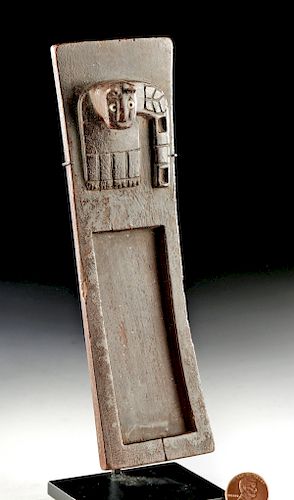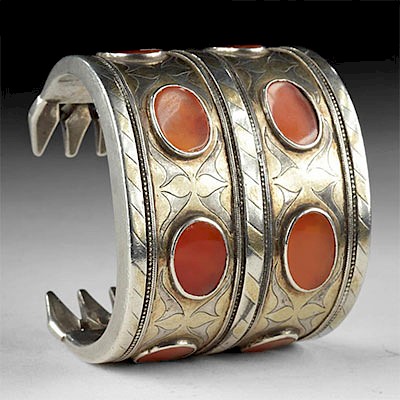Huari Wood Snuff Tray - Jaguar Relief w/ Shell Eyes
Lot 110
About Seller
Artemis Fine Arts
686 S Taylor Ave, Ste 106
Louisville, CO 80027
United States
Selling antiquities, ancient and ethnographic art online since 1993, Artemis Gallery specializes in Classical Antiquities (Egyptian, Greek, Roman, Near Eastern), Asian, Pre-Columbian, African / Tribal / Oceanographic art. Our extensive inventory includes pottery, stone, metal, wood, glass and textil...Read more
Estimate:
$1,200 - $1,800
Absentee vs Live bid
Two ways to bid:
- Leave a max absentee bid and the platform will bid on your behalf up to your maximum bid during the live auction.
- Bid live during the auction and your bids will be submitted real-time to the auctioneer.
Bid Increments
| Price | Bid Increment |
|---|---|
| $0 | $25 |
| $300 | $50 |
| $1,000 | $100 |
| $2,000 | $250 |
| $5,000 | $500 |
| $10,000 | $1,000 |
| $20,000 | $2,500 |
| $50,000 | $5,000 |
| $100,000 | $10,000 |
| $200,000 | $20,000 |
About Auction
By Artemis Fine Arts
Aug 6, 2019
Set Reminder
2019-08-06 11:00:00
2019-08-06 11:00:00
America/New_York
Bidsquare
Bidsquare : VARIETY SALE | Antiquities & Ethnographic Art
https://www.bidsquare.com/auctions/artemis-gallery/variety-sale-antiquities-ethnographic-art-4326
Around the world & back in time - be amazed at the treasures you will find. Antiquities from Egypt, Greece, Italy and the Near East, Asian, Pre-Columbian, African / Tribal / Oceanic, Native American, Spanish Colonial, Russian Icons, Fine Art, much more! All categories, all price ranges... Artemis Fine Arts info@artemisfinearts.com
Around the world & back in time - be amazed at the treasures you will find. Antiquities from Egypt, Greece, Italy and the Near East, Asian, Pre-Columbian, African / Tribal / Oceanic, Native American, Spanish Colonial, Russian Icons, Fine Art, much more! All categories, all price ranges... Artemis Fine Arts info@artemisfinearts.com
- Lot Description
Pre-Columbian, Peru, Huari/Wari culture, ca. 6th to 9th century CE. A beautifully preserved, dark wooden tray of a gently curved rectangular form with a large, shallow, rectangular depression for preparing hallucinogenic drugs to be used in rituals at one end and a fabulous jaguar skillfully carved in low (body) to high (head) relief at the opposite end. The eyes are delineated with black shell and iridescent mother-of-pearl (also known as nacre) inlays. The jaguar symbolized power and might throughout the Pre-Columbian world. Warriors, rulers, hunters, and shamans alike associated themselves with this king of beasts, the largest and most powerful feline in the New World. As a nocturnal animal that sleeps in caves and dark places and creeps quietly in the forest, the jaguar also evoked great mystery. No wonder this wild feline captured the ancients' imaginations. Size: 2.25" W x 7.25" H (5.7 cm x 18.4 cm)
The Huari/Wari culture began to develop during the late Moche era. This culture, centered on a capital to the south of Moche territory in the central highlands of Peru, rose as the Moche culture fell apart and before the Chimu asserted themselves on the north coast. They had extensive contact with other regions in the Andes, most notably the Tiahuanaco in present-day Bolivia, and the Nazca and the Pachacamac on the south and central coast of Peru. Hence there is no homogenous Huari style. Instead we see a wide range of visual expressions in their wood carvings and ceramics.
Provenance: ex-Merrin Gallery, New York, New York, USA; ex-private West Coast, USA collection, acquired in the 2000s
All items legal to buy/sell under U.S. Statute covering cultural patrimony Code 2600, CHAPTER 14, and are guaranteed to be as described or your money back.
A Certificate of Authenticity will accompany all winning bids.
We ship worldwide and handle all shipping in-house for your convenience.
#148184Chips to peripheries. One surface fissure to bottom center of tray border. Eye inlays are intact. Two recesses in jaguar tail may have once held shell inlays as well.Condition
- Shipping Info
-
All shipping is handled in-house for your convenience. Your invoice from Artemis Gallery will include shipping calculation instructions. If in doubt, please inquire BEFORE bidding for estimated shipping costs for individual items.
-
- Buyer's Premium



 EUR
EUR CAD
CAD AUD
AUD GBP
GBP MXN
MXN HKD
HKD CNY
CNY MYR
MYR SEK
SEK SGD
SGD CHF
CHF THB
THB














